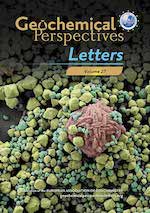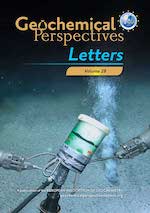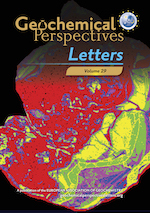K-Ca dating and Ca isotope composition of the oldest Solar System lava, Erg Chech 002
Affiliations | Corresponding Author | Cite as | Funding information- Share this article





-
Article views:1,500Cumulative count of HTML views and PDF downloads.
- Download Citation
- Rights & Permissions
top
Abstract
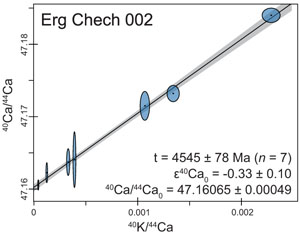
Figures
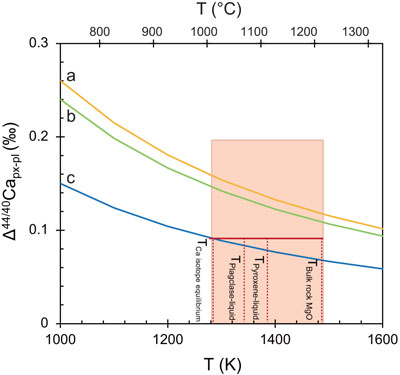 Figure 1 Plot of Δ44/40Capx-pl versus equilibrium temperature of minerals. The red square represents the range of fractionation between pyroxenes and plagioclases and the relative temperature of mineral differentiation. Three solid lines are theoretical equations of equilibrium fractionation between pyroxenes and plagioclase: a, diopside-labradorite (Antonelli et al., 2019); b, diopside-anorthite (Zhang et al., 2018); c, diopside-anorthite (Huang et al., 2019). Four dashed lines represent equilibrium temperatures determined by different methods. | 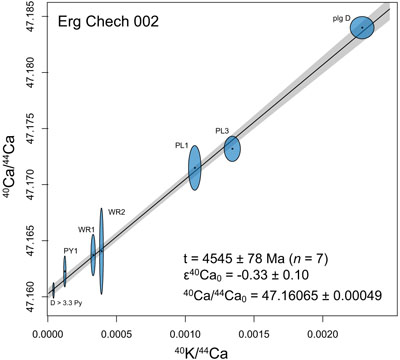 Figure 2 K-Ca isochron defined by pyroxenes, plagioclases, and bulk rock fractions of EC 002 using IsoplotR (Vermeesch, 2018). The error bars correspond to the 2 s.e. on the ratios. Seven data points define a linear array corresponding to a K-Ca age of 4545 ± 78 Ma for λ(40K) = 0.5543 Ga−1 (Steiger and Jäger, 1977). | 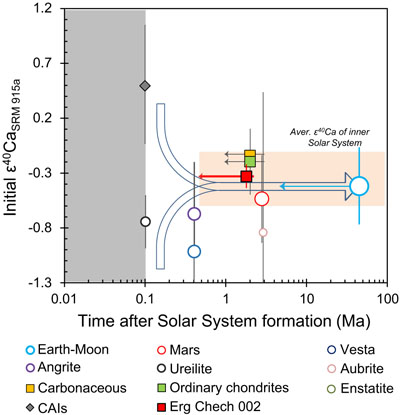 Figure 3 Time scale for homogenisation of ɛ40Ca values in the protoplanetary disk, after Simon et al. (2009). The ɛ40Ca of chondrites and planets are homogeneous since the formation of early planetesimals (∼1 Ma). The formation of CAIs is considered to represent the time of formation of formation of the Solar System or a maximum of ∼0.1 Ma after the formation of the Solar System (Montmerle et al., 2006). Timing of accretion of different planet bodies is from Schiller et al. (2018). The latest accretion ages of meteorites are set by their formation age: EC 002 (0.43–1.80 Ma, derived from the 26Al-26Mg system with different initial 27Al/26Al ratios; Fang et al., 2022); chondrites (mostly around 1–3 Ma; Krot et al., 2009). The ɛ40Ca values of different planets and chondrites are taken from literature, and detailed information is reported in Table S-3. | 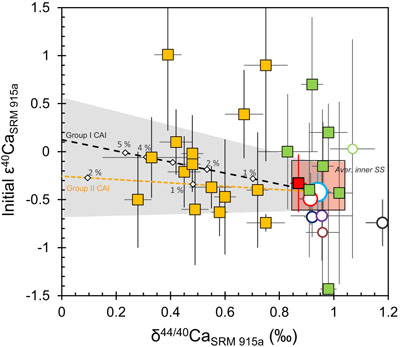 Figure 4 Plot of ɛ40Ca values versus δ44/40Ca values of different chondrites and planetary bodies; symbols as in Figure 3. The two dashed lines represent the mixing curves between bulk Earth and group I and II refractory inclusions. Detailed information is reported in Table S-3. |
| Figure 1 | Figure 2 | Figure 3 | Figure 4 |
top
Introduction
Some evolved, silica-rich achondrites have been the major source of knowledge on early Solar System crustal magmatism (e.g., Day et al., 2009
Day, J.M.D., Ash, R.D., Liu, Y., Bellucci, J.J., Rumble III, D., McDonough, W.F., Walker, R.J., Taylor, L.A. (2009) Early formation of evolved asteroidal crust. Nature 457, 179–182. https://doi.org/10.1038/nature07651
; Srinivasan et al., 2018Srinivasan, P., Dunlap, D.R., Agee, C.B., Wadhwa, M., Coleff, D., Ziegler, K., Zeigler, R., McCubbin, F.M. (2018) Silica-rich volcanism in the early solar system dated at 4.565 Ga. Nature Communications 9, 3036. https://doi.org/10.1038/s41467-018-05501-0
). Erg Chech 002 (EC 002) is an andesite achondrite, with high MgO and FeO content and a smooth trace element pattern, which is quite different from other andesitic achondrites but closely matches the experimental melts obtained from non-carbonaceous chondritic composition (Collinet and Grove, 2020Collinet, M., Grove, T.L. (2020) Widespread production of silica- and alkali-rich melts at the onset of planetesimal melting. Geochimica et Cosmochimica Acta 277, 334–357. https://doi.org/10.1016/j.gca.2020.03.005
; Barrat et al., 2021Barrat, J.-A., Chaussidon, M., Yamaguchi, A., Beck, P., Villeneuve, J., Byrne, D.J., Broadley, M.W., Marty, B. (2021) A 4,565-My-old andesite from an extinct chondritic protoplanet. Proceedings of the National Academy of Sciences 118, e2026129118. https://doi.org/10.1073/pnas.2026129118
). The short-lived radioactive system 26Al-26Mg (t1/2 = 0.705 Ma) yields a precise relative age (1.80 ± 0.01 Ma after CAI formation), which suggests that EC 002 is the oldest magmatic rock and represents the primordial crusts from a protoplanet in the early Solar System (Fang et al., 2022Fang, L., Frossard, P., Boyet, M., Bouvier, A., Barrat, J.-A., Chaussidon, M., Moynier, F. (2022) Half-life and initial Solar System abundance of 146Sm determined from the oldest andesitic meteorite. Proceedings of the National Academy of Sciences 119, e2120933119. https://doi.org/10.1073/pnas.2120933119
). 53Mn-53Cr dating returned consistently old ages comprising 0.7 ± 0.6 Ma (Zhu et al., 2022Zhu, K., Becker, H., Li, S.-J., Fan, Y., Liu, X.-N., Elliott, T. (2022) Radiogenic chromium isotope evidence for the earliest planetary volcanism and crust formation in the Solar system. Monthly Notices of the Royal Astronomical Society: Letters 515, L39–L44. https://doi.org/10.1093/mnrasl/slac061
) and 1.73 ± 0.96 Ma (Anand et al., 2022Anand, A., Kruttasch, P.M., Mezger, K. (2022) 53Mn-53Cr chronology and ɛ54Cr-Δ17O genealogy of Erg Chech 002: the oldest andesite in the Solar System. Meteoritics & Planetary Science 57, 2003–2016. https://doi.org/10.1111/maps.13916.
) after CAI formation. Compared to the age of EC 002 from the 26Al-26Mg and 53Mn-53Cr systems relative to the initial Solary System, long lived isotopic systems, including 40K-40Ar (4534+117−125 Ma, 1σ) and 147Sm-143Nd (4521 ± 152 Ma, 2σ), returned large errors on absolute ages (Barrat et al., 2021Barrat, J.-A., Chaussidon, M., Yamaguchi, A., Beck, P., Villeneuve, J., Byrne, D.J., Broadley, M.W., Marty, B. (2021) A 4,565-My-old andesite from an extinct chondritic protoplanet. Proceedings of the National Academy of Sciences 118, e2026129118. https://doi.org/10.1073/pnas.2026129118
; Fang et al., 2022Fang, L., Frossard, P., Boyet, M., Bouvier, A., Barrat, J.-A., Chaussidon, M., Moynier, F. (2022) Half-life and initial Solar System abundance of 146Sm determined from the oldest andesitic meteorite. Proceedings of the National Academy of Sciences 119, e2120933119. https://doi.org/10.1073/pnas.2120933119
). Furthermore, the negative anomalies on thulium and nucleosynthetic anomalies on Nd isotopes hint that the parent body of EC 002 originated from a non-carbonaceous reservoir (Barrat et al., 2021Barrat, J.-A., Chaussidon, M., Yamaguchi, A., Beck, P., Villeneuve, J., Byrne, D.J., Broadley, M.W., Marty, B. (2021) A 4,565-My-old andesite from an extinct chondritic protoplanet. Proceedings of the National Academy of Sciences 118, e2026129118. https://doi.org/10.1073/pnas.2026129118
; Fang et al., 2022Fang, L., Frossard, P., Boyet, M., Bouvier, A., Barrat, J.-A., Chaussidon, M., Moynier, F. (2022) Half-life and initial Solar System abundance of 146Sm determined from the oldest andesitic meteorite. Proceedings of the National Academy of Sciences 119, e2120933119. https://doi.org/10.1073/pnas.2120933119
and references therein). To further constrain the accretion history and relationship between the parent body of EC 002 and other planetary embryos, improved geochronology and isotopic tracers are sought for more evidence.Calcium (Ca) isotopes provide powerful tools for tracing planetary formation and evolution by studying the stable isotopic variations, radiogenic enrichment, and nucleosynthetic anomalies (Russell et al., 1978
Russell, W.A., Papanastassiou, D.A., Tombrello, T.A. (1978) Ca isotope fractionation on the Earth and other solar system materials. Geochimica et Cosmochimica Acta 42, 1075–1090. https://doi.org/10.1016/0016-7037(78)90105-9
). Given that Ca is a major element, 40K-40Ca dating could be well suited to date precious samples using the most limited mass of minerals (Shih et al., 1993Shih, C.-Y., Nyquist, L.E., Wiesmann, H. (1993) K-Ca chronology of lunar granites. Geochimica et Cosmochimica Acta 57, 4827–4841. https://doi.org/10.1016/0016-7037(93)90202-8
). The novel collision cell (CC)-MC-ICP-MS, Nu Sapphire, is promising for Ca isotope measurements, including the abundance of 40Ca, which is impossible to measure by normal MC-ICP-MS due to the interference of 40K. Both stable and radiogenic Ca isotopic data can be obtained with high precision and the most limited sample consumption (∼100 ng of Ca for each measurement; Dai et al., 2022Dai, W., Moynier, F., Paquet, M., Moureau, J., Debret, B., Siebert, J., Gerard, Y., Zhao, Y. (2022) Calcium isotope measurements using a collision cell (CC)-MC-ICP-MS. Chemical Geology 590, 120688. https://doi.org/10.1016/j.chemgeo.2021.120688
; Moynier et al., 2022Moynier, F., Dai, W., Yokoyama, T., Hu, Y., Paquet, M., et al. (2022) The Solar System calcium isotopic composition inferred from Ryugu samples. Geochemical Perspectives Letters 24, 1–6. https://doi.org/10.7185/geochemlet.2238
). EC 002, being the oldest achondrite, is an ideal sample to test the application of CC-MC-ICP-MS for future 40K-40Ca dating.top
Equilibrium Ca Isotope Fractionation between Mineral Separates
We selected two pyroxene fractions and three plagioclase fractions, together with two bulk rock fractions which have been used for 26Al-26Mg and 147Sm-143Nd systematics, for Ca isotope analysis (Fang et al., 2022
Fang, L., Frossard, P., Boyet, M., Bouvier, A., Barrat, J.-A., Chaussidon, M., Moynier, F. (2022) Half-life and initial Solar System abundance of 146Sm determined from the oldest andesitic meteorite. Proceedings of the National Academy of Sciences 119, e2120933119. https://doi.org/10.1073/pnas.2120933119
). Our method has the advantage of providing both stable and radiogenic Ca isotopic composition simultaneously (noted as δ44/40Ca and ɛ40Ca relative to SRM 915a standard; Table S-1, Supplementary Information). The stable isotopic composition can be used to test whether minerals are within isotopic equilibrium, which is a prerequisite for radiometric dating but rarely tested. Considered as a melting product, EC 002 is also a well suited sample for studying stable Ca isotope fractionation during early planetary differentiation.The δ44/40Ca values of two bulk rock fractions are 0.88 ± 0.07 ‰ (2 s.d.) and 0.85 ± 0.11 ‰ (2 s.d.), which suggests that the δ44/40Ca value of Erg Chech 002 is 0.87 ± 0.05 ‰ (2 s.d.), similar within error to the composition of most inner solar system planetary materials (Valdes et al., 2021
Valdes, M.C., Bermingham, K.R., Huang, S., Simon, J.I. (2021) Calcium isotope cosmochemistry. Chemical Geology 581, 120396. https://doi.org/10.1016/j.chemgeo.2021.120396
). Meanwhile, limited Ca isotope difference is observed between separated pyroxenes and plagioclases. Two pyroxene fractions show a slightly higher δ44/40Ca values (0.84 ± 0.05 ‰, 2 s.e., n = 2) than that of plagioclase fractions (0.75 ± 0.10 ‰, 2 s.e., n = 3). Therefore, the Ca isotope difference between pyroxene and plagioclase is around 0.09 ± 0.11 ‰ (2 s.e.), indistinguishable within uncertainty. Such limited variation in δ44/40Ca typically reflects the equilibrium fractionation between minerals, while kinetic isotopic fractionation caused by chemical diffusion would be of much larger magnitude (Antonelli et al., 2019Antonelli, M.A., Schiller, M., Schauble, E.A., Mittal, T., DePaolo, D.J., Chacko, T., Grew, E.S., Tripoli, B. (2019) Kinetic and equilibrium Ca isotope effects in high-T rocks and minerals. Earth and Planetary Science Letters 517, 71–82. https://doi.org/10.1016/j.epsl.2019.04.013
). Different from capture phenocrysts, the mineral fractions we selected are from the matrix. These fractions have no significant chemical zoning which supports the fact that chemical and isotopic equilibrium should have been achieved during the cooling of the lava (Barrat et al., 2021Barrat, J.-A., Chaussidon, M., Yamaguchi, A., Beck, P., Villeneuve, J., Byrne, D.J., Broadley, M.W., Marty, B. (2021) A 4,565-My-old andesite from an extinct chondritic protoplanet. Proceedings of the National Academy of Sciences 118, e2026129118. https://doi.org/10.1073/pnas.2026129118
). Based on theoretical calculations, the Ca isotope fractionation between pyroxenes and plagioclases should record an equilibrium temperature higher than 1000 °C (Fig. 1). The liquidus temperature of EC 002 could be roughly estimated by its bulk MgO content and mineral compositions. Two mineral-liquid thermometers provide the equilibrium temperature of 1071 °C and 1114 °C, meanwhile, the melting temperature calculated from its MgO content is ∼1224 °C (Putirka, 2008Putirka, K.D. (2008) Thermometers and Barometers for Volcanic Systems. Reviews in Mineralogy and Geochemistry 69, 61–120. https://doi.org/10.2138/rmg.2008.69.3
; Barrat et al., 2021Barrat, J.-A., Chaussidon, M., Yamaguchi, A., Beck, P., Villeneuve, J., Byrne, D.J., Broadley, M.W., Marty, B. (2021) A 4,565-My-old andesite from an extinct chondritic protoplanet. Proceedings of the National Academy of Sciences 118, e2026129118. https://doi.org/10.1073/pnas.2026129118
). The highly consistent estimated temperature between Ca isotopes and petrology evidence suggests that pyroxenes and plagioclases are at isotopic equilibrium in EC 002 since its formation.
Figure 1 Plot of Δ44/40Capx-pl versus equilibrium temperature of minerals. The red square represents the range of fractionation between pyroxenes and plagioclases and the relative temperature of mineral differentiation. Three solid lines are theoretical equations of equilibrium fractionation between pyroxenes and plagioclase: a, diopside-labradorite (Antonelli et al., 2019
Antonelli, M.A., Schiller, M., Schauble, E.A., Mittal, T., DePaolo, D.J., Chacko, T., Grew, E.S., Tripoli, B. (2019) Kinetic and equilibrium Ca isotope effects in high-T rocks and minerals. Earth and Planetary Science Letters 517, 71–82. https://doi.org/10.1016/j.epsl.2019.04.013
); b, diopside-anorthite (Zhang et al., 2018Zhang, H., Wang, Y., He, Y., Teng, F.-Z., Jacobsen, S.B., Helz, R.T., Marsh, B.D., Huang, S. (2018) No Measurable Calcium Isotopic Fractionation During Crystallization of Kilauea Iki Lava Lake. Geochemistry, Geophysics, Geosystems 19, 3128–3139. https://doi.org/10.1029/2018GC007506
); c, diopside-anorthite (Huang et al., 2019Huang, F., Zhou, C., Wang, W., Kang, J., Wu, Z. (2019) First-principles calculations of equilibrium Ca isotope fractionation: Implications for oldhamite formation and evolution of lunar magma ocean. Earth and Planetary Science Letters 510, 153–160. https://doi.org/10.1016/j.epsl.2018.12.034
). Four dashed lines represent equilibrium temperatures determined by different methods.top
Modelling the Ca Isotope Fractionation during Partial Melting of the EC 002 Parent Body
Partial melting would have affected the bulk Ca isotopic composition of the EC 002 lava. This effect needs to be corrected for estimating the composition of the parent body. The trace and major element compositions of EC 002 correspond to high proportions of melting (around 20–25 %) of an ordinary chondrite-like parent body (Barrat et al., 2021
Barrat, J.-A., Chaussidon, M., Yamaguchi, A., Beck, P., Villeneuve, J., Byrne, D.J., Broadley, M.W., Marty, B. (2021) A 4,565-My-old andesite from an extinct chondritic protoplanet. Proceedings of the National Academy of Sciences 118, e2026129118. https://doi.org/10.1073/pnas.2026129118
). Considering that the melting temperature for EC 002 is ∼1224 °C, a simple calculation based on the incremental non-modal batch melting model of an ordinary chondrite-like parent body can be used to estimate the effect of partial melting and obtain the original Ca isotope composition (see Supplementary Information for more details). Under this scenario, most of the Ca (>85 %) was extracted from plagioclases and augites and caused limited fractionation (∼0.1 ‰) between source materials and melts. Therefore, the δ44/40Ca of EC 002 parent body is estimated to be around 0.94 ‰ (Fig. S-4). This result is distinct from carbonaceous meteorites and Ryugu samples (Moynier et al., 2022Moynier, F., Dai, W., Yokoyama, T., Hu, Y., Paquet, M., et al. (2022) The Solar System calcium isotopic composition inferred from Ryugu samples. Geochemical Perspectives Letters 24, 1–6. https://doi.org/10.7185/geochemlet.2238
) and provides further evidence for a non-carbonaceous chondrite parent body (Valdes et al., 2021Valdes, M.C., Bermingham, K.R., Huang, S., Simon, J.I. (2021) Calcium isotope cosmochemistry. Chemical Geology 581, 120396. https://doi.org/10.1016/j.chemgeo.2021.120396
).top
K-Ca Systematics of EC 002
The 40K-40Ca data and 40Ca/44Ca ratio of mineral separates yield an age of 4545 ± 78 Ma (2σ error) with an initial 40Ca/44Ca ratio of 47.16065 ± 0.00049 (2σ) (Fig. 2). The 40K-40Ca age for EC 002 is consistent with the 40K-40Ar (4534+117−125 Ma) and 147Sm-143Nd ages (4521 ± 152 Ma) obtained from the same mineral fractions, but with an improvement on the error by about a factor 2, and also consistent with the closure age for the 26Al-26Mg system (4565.5–4566.9 Ma) within uncertainties (Barrat et al., 2021
Barrat, J.-A., Chaussidon, M., Yamaguchi, A., Beck, P., Villeneuve, J., Byrne, D.J., Broadley, M.W., Marty, B. (2021) A 4,565-My-old andesite from an extinct chondritic protoplanet. Proceedings of the National Academy of Sciences 118, e2026129118. https://doi.org/10.1073/pnas.2026129118
; Fang et al., 2022Fang, L., Frossard, P., Boyet, M., Bouvier, A., Barrat, J.-A., Chaussidon, M., Moynier, F. (2022) Half-life and initial Solar System abundance of 146Sm determined from the oldest andesitic meteorite. Proceedings of the National Academy of Sciences 119, e2120933119. https://doi.org/10.1073/pnas.2120933119
).
Figure 2 K-Ca isochron defined by pyroxenes, plagioclases, and bulk rock fractions of EC 002 using IsoplotR (Vermeesch, 2018
Vermeesch, P. (2018) IsoplotR: A free and open toolbox for geochronology. Geoscience Frontiers 9, 1479–1493. https://doi.org/10.1016/j.gsf.2018.04.001
). The error bars correspond to the 2 s.e. on the ratios. Seven data points define a linear array corresponding to a K-Ca age of 4545 ± 78 Ma for λ(40K) = 0.5543 Ga−1 (Steiger and Jäger, 1977Steiger, R.H., Jäger, E. (1977) Subcommission on geochronology: Convention on the use of decay constants in geo- and cosmochronology. Earth and Planetary Science Letters 36, 359–362. https://doi.org/10.1016/0012-821X(77)90060-7
).The resetting of the isotopic system would occur when elemental and isotopic diffusion happened under secondary events. For the K-Ca system, the relatively slow diffusion coefficients of Ca can make it more resistant to reheating processes than the Rb-Sr or K-Ar systems (Shih et al., 1994
Shih, C.-Y., Nyquist, L.E., Bogard, D.D., Wiesmann, H. (1994) K-Ca and Rb-Sr dating of two lunar granites: Relative chronometer resetting. Geochimica et Cosmochimica Acta 58, 3101–3116. https://doi.org/10.1016/0016-7037(94)90182-1
). The cooling rate of EC 002 is estimated by diffusion of Fe‐Mg in orthopyroxene xenocrysts (∼5–10 °C/yr), indicating that the closure temperature from pyroxenes and plagioclases should be around 1000 °C and that it only took decades for EC 002 to close the K-Ca system (Reynard et al., 2006Reynard, B., Beck, P., Barrat, J.-A., Bohn, M. (2006) Pyroxene Crystal Chemistry and the Late Cooling History of NWA 2737. 37th Annual Lunar and Planetary Science Conference, 13–17 March 2006, League City, Texas, abstract no. 1963. https://www.lpi.usra.edu/meetings/lpsc2006/pdf/1963.pdf
; Barrat et al., 2021Barrat, J.-A., Chaussidon, M., Yamaguchi, A., Beck, P., Villeneuve, J., Byrne, D.J., Broadley, M.W., Marty, B. (2021) A 4,565-My-old andesite from an extinct chondritic protoplanet. Proceedings of the National Academy of Sciences 118, e2026129118. https://doi.org/10.1073/pnas.2026129118
). The preservation of the magmatic equilibrium is supported by the consistent equilibrium temperature calculated by mineral compositions and the stable Ca isotope data. It further suggests the K-Ca dating age reflects its formation event.The reported 40K-40Ca ages of extraterrestrial samples are limited and all cases were obtained using TIMS (Shih et al., 1993
Shih, C.-Y., Nyquist, L.E., Wiesmann, H. (1993) K-Ca chronology of lunar granites. Geochimica et Cosmochimica Acta 57, 4827–4841. https://doi.org/10.1016/0016-7037(93)90202-8
; Yokoyama et al., 2017Yokoyama, T., Misawa, K., Okano, O., Shih, C.-Y., Nyquist, L.E., Simon, J.I., Tappa, M.J., Yoneda, S. (2017) Extreme early solar system chemical fractionation recorded by alkali-rich clasts contained in ordinary chondrite breccias. Earth and Planetary Science Letters 458, 233–240. https://doi.org/10.1016/j.epsl.2016.10.037
). These ages commonly have less precision than other systems, such as Rb-Sr, due to the limited fractionation of K/Ca ratio in most igneous rocks and the high abundance of 40Ca compared to 40K. While the mineral separates of EC 002 comprised a relatively small range of 40K/40Ca ratios, yielding ∼5 ɛ-unit enrichments on 40Ca/44Ca ratios, a precise and accurate age was still obtained by using the CC-MC-ICP-MS, Nu Sapphire. Given the small amount of Ca processed for each phase (∼200 ng for each individual measurement) which corresponds to less than 0.1 mg of minerals, this method displays great potential for future chronology of precious extraterrestrial materials such as future samples returned by space missions.top
Initial ɛ40Ca Value of EC 002 and Implications for the Ca Isotope Distribution in the Early Solar System
The K-Ca isochron is obtained from the variation in the abundance of the radiogenic 40Ca in minerals with different K/Ca ratios. Meanwhile, the intercept of the K-Ca isochron represents the initial ɛ40Ca value of EC 002 (−0.33 ± 0.10) and reflects its parent body’s value at the time of its accretion. Previous studies show variable ɛ40Ca among different carbonaceous and ordinary chondrites which range from −0.74 to +1.01 and −1.43 to +0.83, respectively (Simon et al., 2009
Simon, J.I., DePaolo, D.J., Moynier, F. (2009) Calcium Isotope Composition of Meteorites, Earth, and Mars. The Astrophysical Journal 702, 707–715. https://doi.org/10.1088/0004-637X/702/1/707
; Huang and Jacobsen, 2017Huang, S.C., Jacobsen, S.B. (2017) Calcium isotopic compositions of chondrites. Geochimica et Cosmochimica Acta 201, 364–376. https://doi.org/10.1016/j.gca.2016.09.039
; Yokoyama et al., 2017Yokoyama, T., Misawa, K., Okano, O., Shih, C.-Y., Nyquist, L.E., Simon, J.I., Tappa, M.J., Yoneda, S. (2017) Extreme early solar system chemical fractionation recorded by alkali-rich clasts contained in ordinary chondrite breccias. Earth and Planetary Science Letters 458, 233–240. https://doi.org/10.1016/j.epsl.2016.10.037
; Moynier et al., 2022Moynier, F., Dai, W., Yokoyama, T., Hu, Y., Paquet, M., et al. (2022) The Solar System calcium isotopic composition inferred from Ryugu samples. Geochemical Perspectives Letters 24, 1–6. https://doi.org/10.7185/geochemlet.2238
). However, the average ɛ40Ca of these chondrites mostly cluster and return a ɛ40Ca value of −0.23 ± 0.36 (2 s.e., n = 15) for ordinary chondrites and −0.12 ± 0.27 (2 s.e., n = 15) for carbonaceous chondrites including the asteroid Ryugu (Table S-4, Fig. 3). The ɛ40Ca value of EC 002 which represents the average of its parent body, is similar to those of chondrites and rocky planets in inner Solar System, such as Mars and Earth, within uncertainty (Fig. S-5). This observation suggests a homogenous 40Ca/44Ca distribution within early planetesimals, as early as 1.80 ± 0.01 Ma (the age of EC 002). Given that ɛ40Ca is variable between refractory inclusions (mostly between −4 to + 4 ɛ-units; Simon et al., 2009Simon, J.I., DePaolo, D.J., Moynier, F. (2009) Calcium Isotope Composition of Meteorites, Earth, and Mars. The Astrophysical Journal 702, 707–715. https://doi.org/10.1088/0004-637X/702/1/707
and reference therein), this homogenisation must have occurred rapidly at the birth of Solar System (Fig. 3).
Figure 3 Time scale for homogenisation of ɛ40Ca values in the protoplanetary disk, after Simon et al. (2009)
Simon, J.I., DePaolo, D.J., Moynier, F. (2009) Calcium Isotope Composition of Meteorites, Earth, and Mars. The Astrophysical Journal 702, 707–715. https://doi.org/10.1088/0004-637X/702/1/707
. The ɛ40Ca of chondrites and planets are homogeneous since the formation of early planetesimals (∼1 Ma). The formation of CAIs is considered to represent the time of formation of formation of the Solar System or a maximum of ∼0.1 Ma after the formation of the Solar System (Montmerle et al., 2006Montmerle, T., Augereau, J.-C., Chaussidon, M., Gounelle, M., Marty, B., Morbidelli, A. (2006) 3. Solar System Formation and Early Evolution: the First 100 Million Years. Earth, Moon, and Planets 98, 39–95. https://doi.org/10.1007/s11038-006-9087-5
). Timing of accretion of different planet bodies is from Schiller et al. (2018)Schiller, M., Bizzarro, M., Fernandes, V.A. (2018) Isotopic evolution of the protoplanetary disk and the building blocks of Earth and the Moon. Nature 555, 507–510. https://doi.org/10.1038/nature25990
. The latest accretion ages of meteorites are set by their formation age: EC 002 (0.43–1.80 Ma, derived from the 26Al-26Mg system with different initial 27Al/26Al ratios; Fang et al., 2022Fang, L., Frossard, P., Boyet, M., Bouvier, A., Barrat, J.-A., Chaussidon, M., Moynier, F. (2022) Half-life and initial Solar System abundance of 146Sm determined from the oldest andesitic meteorite. Proceedings of the National Academy of Sciences 119, e2120933119. https://doi.org/10.1073/pnas.2120933119
); chondrites (mostly around 1–3 Ma; Krot et al., 2009Krot, A.N., Amelin, Y., Bland, P., Ciesla, F.J., Connelly, J., Davis, A.M., Huss, G.R., Hutcheon, I.D., Makide, K., Nagashima, K., Nyquist, L.E., Russell, S.S., Scott, E.R.D., Thrane, K., Yurimoto, H., Yin, Q.-Z. (2009) Origin and chronology of chondritic components: A review. Geochimica et Cosmochimica Acta 73, 4963–4997. https://doi.org/10.1016/j.gca.2008.09.039
). The ɛ40Ca values of different planets and chondrites are taken from literature, and detailed information is reported in Table S-3.Ordinary and enstatite chondrites as well as terrestrial rocks have fairly homogeneous δ44/40Ca values, while carbonaceous chondrites including the primitive asteroid Ryugu have variable δ44/40Ca ranging from 0.28 ‰ to 1.19 ‰ (Simon and DePaolo, 2010
Simon, J.I., DePaolo, D.J. (2010) Stable calcium isotopic composition of meteorites and rocky planets. Earth and Planetary Science Letters 289, 457–466. https://doi.org/10.1016/j.epsl.2009.11.035
; Valdes et al., 2014Valdes, M.C., Moreira, M., Foriel, J., Moynier, F. (2014) The nature of Earth’s building blocks as revealed by calcium isotopes. Earth and Planetary Science Letters 394, 135–145. https://doi.org/10.1016/j.epsl.2014.02.052
; Huang and Jacobsen, 2017Huang, S.C., Jacobsen, S.B. (2017) Calcium isotopic compositions of chondrites. Geochimica et Cosmochimica Acta 201, 364–376. https://doi.org/10.1016/j.gca.2016.09.039
; Moynier et al., 2022Moynier, F., Dai, W., Yokoyama, T., Hu, Y., Paquet, M., et al. (2022) The Solar System calcium isotopic composition inferred from Ryugu samples. Geochemical Perspectives Letters 24, 1–6. https://doi.org/10.7185/geochemlet.2238
). Most CAIs are enriched in the lighter Ca isotope due to the large fractionation during condensation (Huang et al., 2012Huang, S., Farkaš, J., Yu, G., Petaev, M.I., Jacobsen, S.B. (2012) Calcium isotopic ratios and rare earth element abundances in refractory inclusions from the Allende CV3 chondrite. Geochimica et Cosmochimica Acta 77, 252–265. https://doi.org/10.1016/j.gca.2011.11.002
; Amsellem et al., 2017Amsellem, E., Moynier, F., Pringle, E.A., Bouvier, A., Chen, H., Day, J.M.D. (2017) Testing the chondrule-rich accretion model for planetary embryos using calcium isotopes. Earth and Planetary Science Letters 469, 75–83. https://doi.org/10.1016/j.epsl.2017.04.022
; Simon et al., 2017Simon, J.I., Jordan, M.K., Tappa, M.J., Schauble, E.A., Kohl, I.E., Young, E.D. (2017) Calcium and titanium isotope fractionation in refractory inclusions: Tracers of condensation and inheritance in the early solar protoplanetary disk. Earth and Planetary Science Letters 472, 277–288. https://doi.org/10.1016/j.epsl.2017.05.002
). Assuming that the homogenisation of Ca isotopes occurred quickly, variable CAI contents in different chondrites could be the main source accounting for the variation on ɛ40Ca and δ44/40Ca among different meteorites. The positive Tm anomalies found in carbonaceous chondrites and their correlation with δ44/40Ca point to a variable distribution of a refractory component similar to that in group II fine grained CAIs between carbonaceous chondrites (Huang et al., 2012Huang, S., Farkaš, J., Yu, G., Petaev, M.I., Jacobsen, S.B. (2012) Calcium isotopic ratios and rare earth element abundances in refractory inclusions from the Allende CV3 chondrite. Geochimica et Cosmochimica Acta 77, 252–265. https://doi.org/10.1016/j.gca.2011.11.002
; Dauphas and Pourmand, 2015Dauphas, N., Pourmand, A. (2015) Thulium anomalies and rare earth element patterns in meteorites and Earth: Nebular fractionation and the nugget effect. Geochimica et Cosmochimica Acta 163, 234–261. https://doi.org/10.1016/j.gca.2015.03.037
). For example, the addition of ∼4 % group I or ∼1.5 % group II CAIs to a non-carbonaceous chondritic Ca isotopic composition could reproduce the range of δ44/40Ca values (as previously suggested by, e.g., Dauphas and Pourmand, 2015Dauphas, N., Pourmand, A. (2015) Thulium anomalies and rare earth element patterns in meteorites and Earth: Nebular fractionation and the nugget effect. Geochimica et Cosmochimica Acta 163, 234–261. https://doi.org/10.1016/j.gca.2015.03.037
), while the effect on ɛ40Ca is more limited (Fig. 4). This may suggest that the inner Solar System is isotopically different from the outer Solar System due to its depletion in refractory materials (e.g., 48Ca anomalies; Schiller et al., 2018Schiller, M., Bizzarro, M., Fernandes, V.A. (2018) Isotopic evolution of the protoplanetary disk and the building blocks of Earth and the Moon. Nature 555, 507–510. https://doi.org/10.1038/nature25990
). As a product of homogenisation during accretion, EC 002 may be taken as a representative sample for the average Ca isotope composition of the inner Solar System.
Figure 4 Plot of ɛ40Ca values versus δ44/40Ca values of different chondrites and planetary bodies; symbols as in Figure 3. The two dashed lines represent the mixing curves between bulk Earth and group I and II refractory inclusions. Detailed information is reported in Table S-3.
top
Acknowledgements
We deeply thank Justin Simon and an anonymous reviewer for constructive comments that greatly improved our manuscript. This work was partly supported by the IPGP analytical platform PARI, Ile-de-France SESAME Grants 12015908, the DIM ACAV+, the ERC grant 101001282 (METAL) (FM).
Editor: Francis McCubbin
top
References
Amsellem, E., Moynier, F., Pringle, E.A., Bouvier, A., Chen, H., Day, J.M.D. (2017) Testing the chondrule-rich accretion model for planetary embryos using calcium isotopes. Earth and Planetary Science Letters 469, 75–83. https://doi.org/10.1016/j.epsl.2017.04.022
 Show in context
Show in context Most CAIs are enriched in the lighter Ca isotope due to the large fractionation during condensation (Huang et al., 2012; Amsellem et al., 2017; Simon et al., 2017).
View in article
Anand, A., Kruttasch, P.M., Mezger, K. (2022) 53Mn-53Cr chronology and ɛ54Cr-Δ17O genealogy of Erg Chech 002: the oldest andesite in the Solar System. Meteoritics & Planetary Science 57, 2003–2016. https://doi.org/10.1111/maps.13916.
 Show in context
Show in context 53Mn-53Cr dating returned consistently old ages comprising 0.7 ± 0.6 Ma (Zhu et al., 2022) and 1.73 ± 0.96 Ma (Anand et al., 2022) after CAI formation.
View in article
Antonelli, M.A., Schiller, M., Schauble, E.A., Mittal, T., DePaolo, D.J., Chacko, T., Grew, E.S., Tripoli, B. (2019) Kinetic and equilibrium Ca isotope effects in high-T rocks and minerals. Earth and Planetary Science Letters 517, 71–82. https://doi.org/10.1016/j.epsl.2019.04.013
 Show in context
Show in context Such limited variation in δ44/40Ca typically reflects the equilibrium fractionation between minerals, while kinetic isotopic fractionation caused by chemical diffusion would be of much larger magnitude (Antonelli et al., 2019).
View in article
Three solid lines are theoretical equations of equilibrium fractionation between pyroxenes and plagioclase: a, diopside-labradorite (Antonelli et al., 2019); b, diopside-anorthite (Zhang et al., 2018); c, diopside-anorthite (Huang et al., 2019).
View in article
Barrat, J.-A., Chaussidon, M., Yamaguchi, A., Beck, P., Villeneuve, J., Byrne, D.J., Broadley, M.W., Marty, B. (2021) A 4,565-My-old andesite from an extinct chondritic protoplanet. Proceedings of the National Academy of Sciences 118, e2026129118. https://doi.org/10.1073/pnas.2026129118
 Show in context
Show in context Erg Chech 002 (EC 002) is an andesite achondrite, with high MgO and FeO content and a smooth trace element pattern, which is quite different from other andesitic achondrites but closely matches the experimental melts obtained from non-carbonaceous chondritic composition (Collinet and Grove, 2020; Barrat et al., 2021).
View in article
Compared to the age of EC 002 from the 26Al-26Mg and 53Mn-53Cr systems relative to the initial Solary System, long lived isotopic systems, including 40K-40Ar (4534+117−125 Ma, 1σ) and 147Sm-143Nd (4521 ± 152 Ma, 2σ), returned large errors on absolute ages (Barrat et al., 2021; Fang et al., 2022).
View in article
Furthermore, the negative anomalies on thulium and nucleosynthetic anomalies on Nd isotopes hint that the parent body of EC 002 originated from a non-carbonaceous reservoir (Barrat et al., 2021; Fang et al., 2022 and references therein).
View in article
These fractions have no significant chemical zoning which supports the fact that chemical and isotopic equilibrium should have been achieved during the cooling of the lava (Barrat et al., 2021).
View in article
The trace and major element compositions of EC 002 correspond to high proportions of melting (around 20–25 %) of an ordinary chondrite-like parent body (Barrat et al., 2021).
View in article
Two mineral-liquid thermometers provide the equilibrium temperature of 1071 °C and 1114 °C, meanwhile, the melting temperature calculated from its MgO content is ∼1224 °C (Putirka, 2008; Barrat et al., 2021).
View in article
The 40K-40Ca age for EC 002 is consistent with the 40K-40Ar (4534+117−125 Ma) and 147Sm-143Nd ages (4521 ± 152 Ma) obtained from the same mineral fractions, but with an improvement on the error by about a factor 2, and also consistent with the closure age for the 26Al-26Mg system (4565.5–4566.9 Ma) within uncertainties (Barrat et al., 2021; Fang et al., 2022).
View in article
The cooling rate of EC 002 is estimated by diffusion of Fe‐Mg in orthopyroxene xenocrysts (∼5–10 °C/yr), indicating that the closure temperature from pyroxenes and plagioclases should be around 1000 °C and that it only took decades for EC 002 to close the K-Ca system (Reynard et al., 2006; Barrat et al., 2021).
View in article
Collinet, M., Grove, T.L. (2020) Widespread production of silica- and alkali-rich melts at the onset of planetesimal melting. Geochimica et Cosmochimica Acta 277, 334–357. https://doi.org/10.1016/j.gca.2020.03.005
 Show in context
Show in context Erg Chech 002 (EC 002) is an andesite achondrite, with high MgO and FeO content and a smooth trace element pattern, which is quite different from other andesitic achondrites but closely matches the experimental melts obtained from non-carbonaceous chondritic composition (Collinet and Grove, 2020; Barrat et al., 2021).
View in article
Dai, W., Moynier, F., Paquet, M., Moureau, J., Debret, B., Siebert, J., Gerard, Y., Zhao, Y. (2022) Calcium isotope measurements using a collision cell (CC)-MC-ICP-MS. Chemical Geology 590, 120688. https://doi.org/10.1016/j.chemgeo.2021.120688
 Show in context
Show in context Both stable and radiogenic Ca isotopic data can be obtained with high precision and the most limited sample consumption (∼100 ng of Ca for each measurement; Dai et al., 2022; Moynier et al., 2022).
View in article
Dauphas, N., Pourmand, A. (2015) Thulium anomalies and rare earth element patterns in meteorites and Earth: Nebular fractionation and the nugget effect. Geochimica et Cosmochimica Acta 163, 234–261. https://doi.org/10.1016/j.gca.2015.03.037
 Show in context
Show in context The positive Tm anomalies found in carbonaceous chondrites and their correlation with δ44/40Ca point to a variable distribution of a refractory component similar to that in group II fine grained CAIs between carbonaceous chondrites (Huang et al., 2012; Dauphas and Pourmand, 2015).
View in article
For example, the addition of ∼4 % group I or ∼1.5 % group II CAIs to a non-carbonaceous chondritic Ca isotopic composition could reproduce the range of δ44/40Ca values (as previously suggested by, e.g., Dauphas and Pourmand, 2015), while the effect on ɛ40Ca is more limited (Fig. 4).
View in article
Day, J.M.D., Ash, R.D., Liu, Y., Bellucci, J.J., Rumble III, D., McDonough, W.F., Walker, R.J., Taylor, L.A. (2009) Early formation of evolved asteroidal crust. Nature 457, 179–182. https://doi.org/10.1038/nature07651
 Show in context
Show in context Some evolved, silica-rich achondrites have been the major source of knowledge on early Solar System crustal magmatism (e.g., Day et al., 2009; Srinivasan et al., 2018).
View in article
Fang, L., Frossard, P., Boyet, M., Bouvier, A., Barrat, J.-A., Chaussidon, M., Moynier, F. (2022) Half-life and initial Solar System abundance of 146Sm determined from the oldest andesitic meteorite. Proceedings of the National Academy of Sciences 119, e2120933119. https://doi.org/10.1073/pnas.2120933119
 Show in context
Show in context The short-lived radioactive system 26Al-26Mg (t1/2 = 0.705 Ma) yields a precise relative age (1.80 ± 0.01 Ma after CAI formation), which suggests that EC 002 is the oldest magmatic rock and represents the primordial crusts from a protoplanet in the early Solar System (Fang et al., 2022).
View in article
Compared to the age of EC 002 from the 26Al-26Mg and 53Mn-53Cr systems relative to the initial Solary System, long lived isotopic systems, including 40K-40Ar (4534+117−125 Ma, 1σ) and 147Sm-143Nd (4521 ± 152 Ma, 2σ), returned large errors on absolute ages (Barrat et al., 2021; Fang et al., 2022).
View in article
Furthermore, the negative anomalies on thulium and nucleosynthetic anomalies on Nd isotopes hint that the parent body of EC 002 originated from a non-carbonaceous reservoir (Barrat et al., 2021; Fang et al., 2022 and references therein).
View in article
We selected two pyroxene fractions and three plagioclase fractions, together with two bulk rock fractions which have been used for 26Al-26Mg and 147Sm-143Nd systematics, for Ca isotope analysis (Fang et al., 2022).
View in article
The 40K-40Ca age for EC 002 is consistent with the 40K-40Ar (4534+117−125 Ma) and 147Sm-143Nd ages (4521 ± 152 Ma) obtained from the same mineral fractions, but with an improvement on the error by about a factor 2, and also consistent with the closure age for the 26Al-26Mg system (4565.5–4566.9 Ma) within uncertainties (Barrat et al., 2021; Fang et al., 2022).
View in article
The latest accretion ages of meteorites are set by their formation age: EC 002 (0.43–1.80 Ma, derived from the 26Al-26Mg system with different initial 27Al/26Al ratios; Fang et al., 2022); chondrites (mostly around 1–3 Ma; Krot et al., 2009).
View in article
Huang, F., Zhou, C., Wang, W., Kang, J., Wu, Z. (2019) First-principles calculations of equilibrium Ca isotope fractionation: Implications for oldhamite formation and evolution of lunar magma ocean. Earth and Planetary Science Letters 510, 153–160. https://doi.org/10.1016/j.epsl.2018.12.034
 Show in context
Show in context Three solid lines are theoretical equations of equilibrium fractionation between pyroxenes and plagioclase: a, diopside-labradorite (Antonelli et al., 2019); b, diopside-anorthite (Zhang et al., 2018); c, diopside-anorthite (Huang et al., 2019).
View in article
Huang, S., Farkaš, J., Yu, G., Petaev, M.I., Jacobsen, S.B. (2012) Calcium isotopic ratios and rare earth element abundances in refractory inclusions from the Allende CV3 chondrite. Geochimica et Cosmochimica Acta 77, 252–265. https://doi.org/10.1016/j.gca.2011.11.002
 Show in context
Show in context Most CAIs are enriched in the lighter Ca isotope due to the large fractionation during condensation (Huang et al., 2012; Amsellem et al., 2017; Simon et al., 2017).
View in article
The positive Tm anomalies found in carbonaceous chondrites and their correlation with δ44/40Ca point to a variable distribution of a refractory component similar to that in group II fine grained CAIs between carbonaceous chondrites (Huang et al., 2012; Dauphas and Pourmand, 2015).
View in article
Huang, S.C., Jacobsen, S.B. (2017) Calcium isotopic compositions of chondrites. Geochimica et Cosmochimica Acta 201, 364–376. https://doi.org/10.1016/j.gca.2016.09.039
 Show in context
Show in context Previous studies show variable ɛ40Ca among different carbonaceous and ordinary chondrites which range from −0.74 to +1.01 and −1.43 to +0.83, respectively (Simon et al., 2009; Huang and Jacobsen, 2017; Yokoyama et al., 2017; Moynier et al., 2022).
View in article
Ordinary and enstatite chondrites as well as terrestrial rocks have fairly homogeneous δ44/40Ca values, while carbonaceous chondrites including the primitive asteroid Ryugu have variable δ44/40Ca ranging from 0.28 ‰ to 1.19 ‰ (Simon and DePaolo, 2010; Valdes et al., 2014; Huang and Jacobsen, 2017; Moynier et al., 2022).
View in article
Krot, A.N., Amelin, Y., Bland, P., Ciesla, F.J., Connelly, J., Davis, A.M., Huss, G.R., Hutcheon, I.D., Makide, K., Nagashima, K., Nyquist, L.E., Russell, S.S., Scott, E.R.D., Thrane, K., Yurimoto, H., Yin, Q.-Z. (2009) Origin and chronology of chondritic components: A review. Geochimica et Cosmochimica Acta 73, 4963–4997. https://doi.org/10.1016/j.gca.2008.09.039
 Show in context
Show in context The latest accretion ages of meteorites are set by their formation age: EC 002 (0.43–1.80 Ma, derived from the 26Al-26Mg system with different initial 27Al/26Al ratios; Fang et al., 2022); chondrites (mostly around 1–3 Ma; Krot et al., 2009).
View in article
Montmerle, T., Augereau, J.-C., Chaussidon, M., Gounelle, M., Marty, B., Morbidelli, A. (2006) 3. Solar System Formation and Early Evolution: the First 100 Million Years. Earth, Moon, and Planets 98, 39–95. https://doi.org/10.1007/s11038-006-9087-5
 Show in context
Show in context The formation of CAIs is considered to represent the time of formation of formation of the Solar System or a maximum of ∼0.1 Ma after the formation of the Solar System (Montmerle et al., 2006.
View in article
Moynier, F., Dai, W., Yokoyama, T., Hu, Y., Paquet, M., et al. (2022) The Solar System calcium isotopic composition inferred from Ryugu samples. Geochemical Perspectives Letters 24, 1–6. https://doi.org/10.7185/geochemlet.2238
 Show in context
Show in context Both stable and radiogenic Ca isotopic data can be obtained with high precision and the most limited sample consumption (∼100 ng of Ca for each measurement; Dai et al., 2022; Moynier et al., 2022).
View in article
This result is distinct from carbonaceous meteorites and Ryugu samples (Moynier et al., 2022) and provides further evidence for a non-carbonaceous chondrite parent body (Valdes et al., 2021).
View in article
Previous studies show variable ɛ40Ca among different carbonaceous and ordinary chondrites which range from −0.74 to +1.01 and −1.43 to +0.83, respectively (Simon et al., 2009; Huang and Jacobsen, 2017; Yokoyama et al., 2017; Moynier et al., 2022).
View in article
Ordinary and enstatite chondrites as well as terrestrial rocks have fairly homogeneous δ44/40Ca values, while carbonaceous chondrites including the primitive asteroid Ryugu have variable δ44/40Ca ranging from 0.28 ‰ to 1.19 ‰ (Simon and DePaolo, 2010; Valdes et al., 2014; Huang and Jacobsen, 2017; Moynier et al., 2022).
View in article
Putirka, K.D. (2008) Thermometers and Barometers for Volcanic Systems. Reviews in Mineralogy and Geochemistry 69, 61–120. https://doi.org/10.2138/rmg.2008.69.3
 Show in context
Show in context Two mineral-liquid thermometers provide the equilibrium temperature of 1071 °C and 1114 °C, meanwhile, the melting temperature calculated from its MgO content is ∼1224 °C (Putirka, 2008; Barrat et al., 2021).
View in article
Reynard, B., Beck, P., Barrat, J.-A., Bohn, M. (2006) Pyroxene Crystal Chemistry and the Late Cooling History of NWA 2737. 37th Annual Lunar and Planetary Science Conference, 13–17 March 2006, League City, Texas, abstract no. 1963. https://www.lpi.usra.edu/meetings/lpsc2006/pdf/1963.pdf
 Show in context
Show in context The cooling rate of EC 002 is estimated by diffusion of Fe‐Mg in orthopyroxene xenocrysts (∼5–10 °C/yr), indicating that the closure temperature from pyroxenes and plagioclases should be around 1000 °C and that it only took decades for EC 002 to close the K-Ca system (Reynard et al., 2006; Barrat et al., 2021).
View in article
Russell, W.A., Papanastassiou, D.A., Tombrello, T.A. (1978) Ca isotope fractionation on the Earth and other solar system materials. Geochimica et Cosmochimica Acta 42, 1075–1090. https://doi.org/10.1016/0016-7037(78)90105-9
 Show in context
Show in context Calcium (Ca) isotopes provide powerful tools for tracing planetary formation and evolution by studying the stable isotopic variations, radiogenic enrichment, and nucleosynthetic anomalies (Russell et al., 1978).
View in article
Schiller, M., Bizzarro, M., Fernandes, V.A. (2018) Isotopic evolution of the protoplanetary disk and the building blocks of Earth and the Moon. Nature 555, 507–510. https://doi.org/10.1038/nature25990
 Show in context
Show in context Timing of accretion of different planet bodies is from Schiller et al. (2018).
View in article
This may suggest that the inner Solar System is isotopically different from the outer Solar System due to its depletion in refractory materials (e.g., 48Ca anomalies; Schiller et al., 2018).
View in article
Shih, C.-Y., Nyquist, L.E., Wiesmann, H. (1993) K-Ca chronology of lunar granites. Geochimica et Cosmochimica Acta 57, 4827–4841. https://doi.org/10.1016/0016-7037(93)90202-8
 Show in context
Show in context Given that Ca is a major element, 40K-40Ca dating could be well suited to date precious samples using the most limited mass of minerals (Shih et al., 1993).
View in article
The reported 40K-40Ca ages of extraterrestrial samples are limited and all cases were obtained using TIMS (Shih et al., 1993; Yokoyama et al., 2017).
View in article
Shih, C.-Y., Nyquist, L.E., Bogard, D.D., Wiesmann, H. (1994) K-Ca and Rb-Sr dating of two lunar granites: Relative chronometer resetting. Geochimica et Cosmochimica Acta 58, 3101–3116. https://doi.org/10.1016/0016-7037(94)90182-1
 Show in context
Show in context For the K-Ca system, the relatively slow diffusion coefficients of Ca can make it more resistant to reheating processes than the Rb-Sr or K-Ar systems (Shih et al., 1994).
View in article
Simon, J.I., DePaolo, D.J. (2010) Stable calcium isotopic composition of meteorites and rocky planets. Earth and Planetary Science Letters 289, 457–466. https://doi.org/10.1016/j.epsl.2009.11.035
 Show in context
Show in context Ordinary and enstatite chondrites as well as terrestrial rocks have fairly homogeneous δ44/40Ca values, while carbonaceous chondrites including the primitive asteroid Ryugu have variable δ44/40Ca ranging from 0.28 ‰ to 1.19 ‰ (Simon and DePaolo, 2010; Valdes et al., 2014; Huang and Jacobsen, 2017; Moynier et al., 2022).
View in article
Simon, J.I., DePaolo, D.J., Moynier, F. (2009) Calcium Isotope Composition of Meteorites, Earth, and Mars. The Astrophysical Journal 702, 707–715. https://doi.org/10.1088/0004-637X/702/1/707
 Show in context
Show in context Previous studies show variable ɛ40Ca among different carbonaceous and ordinary chondrites which range from −0.74 to +1.01 and −1.43 to +0.83, respectively (Simon et al., 2009; Huang and Jacobsen, 2017; Yokoyama et al., 2017; Moynier et al., 2022).
View in article
Given that ɛ40Ca is variable between refractory inclusions (mostly between −4 to + 4 ɛ-units; Simon et al., 2009 and reference therein), this homogenisation must have occurred rapidly at the birth of Solar System (Fig. 3).
View in article
Time scale for homogenisation of ɛ40Ca values in the protoplanetary disk, after Simon et al. (2009).
View in article
Simon, J.I., Jordan, M.K., Tappa, M.J., Schauble, E.A., Kohl, I.E., Young, E.D. (2017) Calcium and titanium isotope fractionation in refractory inclusions: Tracers of condensation and inheritance in the early solar protoplanetary disk. Earth and Planetary Science Letters 472, 277–288. https://doi.org/10.1016/j.epsl.2017.05.002
 Show in context
Show in context Most CAIs are enriched in the lighter Ca isotope due to the large fractionation during condensation (Huang et al., 2012; Amsellem et al., 2017; Simon et al., 2017).
View in article
Srinivasan, P., Dunlap, D.R., Agee, C.B., Wadhwa, M., Coleff, D., Ziegler, K., Zeigler, R., McCubbin, F.M. (2018) Silica-rich volcanism in the early solar system dated at 4.565 Ga. Nature Communications 9, 3036. https://doi.org/10.1038/s41467-018-05501-0
 Show in context
Show in context Some evolved, silica-rich achondrites have been the major source of knowledge on early Solar System crustal magmatism (e.g., Day et al., 2009; Srinivasan et al., 2018).
View in article
Steiger, R.H., Jäger, E. (1977) Subcommission on geochronology: Convention on the use of decay constants in geo- and cosmochronology. Earth and Planetary Science Letters 36, 359–362. https://doi.org/10.1016/0012-821X(77)90060-7
 Show in context
Show in context The error bars correspond to the 2 s.e. on the ratios. Seven data points define a linear array corresponding to a K-Ca age of 4545 ± 78 Ma for λ(40K) = 0.5543 Ga−1 (Steiger and Jäger, 1977).
View in article
Valdes, M.C., Moreira, M., Foriel, J., Moynier, F. (2014) The nature of Earth’s building blocks as revealed by calcium isotopes. Earth and Planetary Science Letters 394, 135–145. https://doi.org/10.1016/j.epsl.2014.02.052
 Show in context
Show in context Ordinary and enstatite chondrites as well as terrestrial rocks have fairly homogeneous δ44/40Ca values, while carbonaceous chondrites including the primitive asteroid Ryugu have variable δ44/40Ca ranging from 0.28 ‰ to 1.19 ‰ (Simon and DePaolo, 2010; Valdes et al., 2014; Huang and Jacobsen, 2017; Moynier et al., 2022).
View in article
Valdes, M.C., Bermingham, K.R., Huang, S., Simon, J.I. (2021) Calcium isotope cosmochemistry. Chemical Geology 581, 120396. https://doi.org/10.1016/j.chemgeo.2021.120396
 Show in context
Show in context The δ44/40Ca values of two bulk rock fractions are 0.88 ± 0.07 ‰ (2 s.d.) and 0.85 ± 0.11 ‰ (2 s.d.), which suggests that the δ44/40Ca value of Erg Chech 002 is 0.87 ± 0.05 ‰ (2 s.d.), similar within error to the composition of most inner solar system planetary materials (Valdes et al., 2021).
View in article
This result is distinct from carbonaceous meteorites and Ryugu samples (Moynier et al., 2022) and provides further evidence for a non-carbonaceous chondrite parent body (Valdes et al., 2021).
View in article
Vermeesch, P. (2018) IsoplotR: A free and open toolbox for geochronology. Geoscience Frontiers 9, 1479–1493. https://doi.org/10.1016/j.gsf.2018.04.001
 Show in context
Show in context K-Ca isochron defined by pyroxenes, plagioclases, and bulk rock fractions of EC 002 using IsoplotR (Vermeesch, 2018).
View in article
Yokoyama, T., Misawa, K., Okano, O., Shih, C.-Y., Nyquist, L.E., Simon, J.I., Tappa, M.J., Yoneda, S. (2017) Extreme early solar system chemical fractionation recorded by alkali-rich clasts contained in ordinary chondrite breccias. Earth and Planetary Science Letters 458, 233–240. https://doi.org/10.1016/j.epsl.2016.10.037
 Show in context
Show in context The reported 40K-40Ca ages of extraterrestrial samples are limited and all cases were obtained using TIMS (Shih et al., 1993; Yokoyama et al., 2017).
View in article
Previous studies show variable ɛ40Ca among different carbonaceous and ordinary chondrites which range from −0.74 to +1.01 and −1.43 to +0.83, respectively (Simon et al., 2009; Huang and Jacobsen, 2017; Yokoyama et al., 2017; Moynier et al., 2022).
View in article
Zhang, H., Wang, Y., He, Y., Teng, F.-Z., Jacobsen, S.B., Helz, R.T., Marsh, B.D., Huang, S. (2018) No Measurable Calcium Isotopic Fractionation During Crystallization of Kilauea Iki Lava Lake. Geochemistry, Geophysics, Geosystems 19, 3128–3139. https://doi.org/10.1029/2018GC007506
 Show in context
Show in context Three solid lines are theoretical equations of equilibrium fractionation between pyroxenes and plagioclase: a, diopside-labradorite (Antonelli et al., 2019); b, diopside-anorthite (Zhang et al., 2018); c, diopside-anorthite (Huang et al., 2019).
View in article
Zhu, K., Becker, H., Li, S.-J., Fan, Y., Liu, X.-N., Elliott, T. (2022) Radiogenic chromium isotope evidence for the earliest planetary volcanism and crust formation in the Solar system. Monthly Notices of the Royal Astronomical Society: Letters 515, L39–L44. https://doi.org/10.1093/mnrasl/slac061
 Show in context
Show in context 53Mn-53Cr dating returned consistently old ages comprising 0.7 ± 0.6 Ma (Zhu et al., 2022) and 1.73 ± 0.96 Ma (Anand et al., 2022) after CAI formation.
View in article
top
Supplementary Information
The Supplementary Information includes:
Download Tables S-3 and S-4 (xlsx)
Download the Supplementary Information (PDF)
Figures
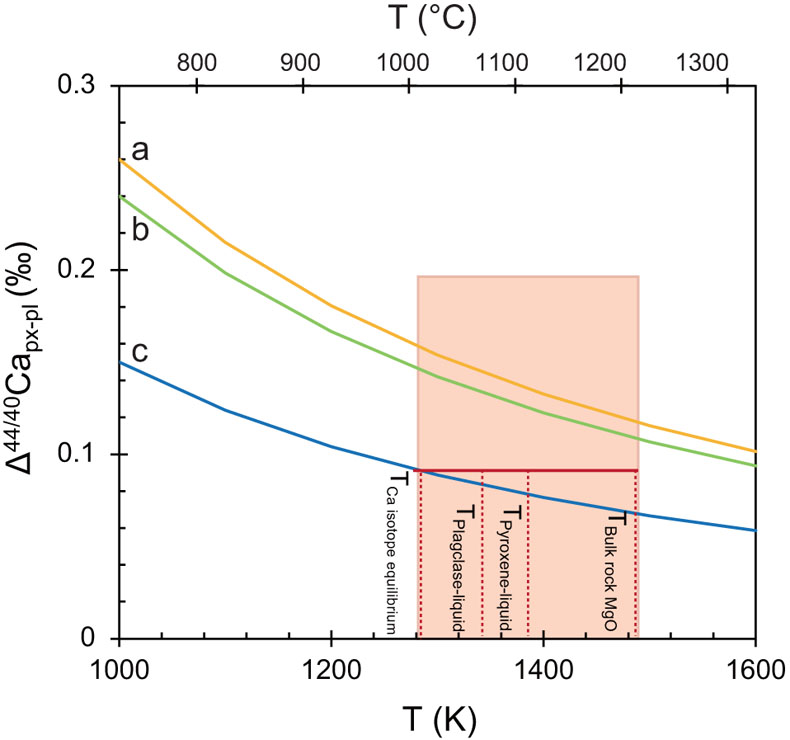
Figure 1 Plot of Δ44/40Capx-pl versus equilibrium temperature of minerals. The red square represents the range of fractionation between pyroxenes and plagioclases and the relative temperature of mineral differentiation. Three solid lines are theoretical equations of equilibrium fractionation between pyroxenes and plagioclase: a, diopside-labradorite (Antonelli et al., 2019
Antonelli, M.A., Schiller, M., Schauble, E.A., Mittal, T., DePaolo, D.J., Chacko, T., Grew, E.S., Tripoli, B. (2019) Kinetic and equilibrium Ca isotope effects in high-T rocks and minerals. Earth and Planetary Science Letters 517, 71–82. https://doi.org/10.1016/j.epsl.2019.04.013
); b, diopside-anorthite (Zhang et al., 2018Zhang, H., Wang, Y., He, Y., Teng, F.-Z., Jacobsen, S.B., Helz, R.T., Marsh, B.D., Huang, S. (2018) No Measurable Calcium Isotopic Fractionation During Crystallization of Kilauea Iki Lava Lake. Geochemistry, Geophysics, Geosystems 19, 3128–3139. https://doi.org/10.1029/2018GC007506
); c, diopside-anorthite (Huang et al., 2019Huang, F., Zhou, C., Wang, W., Kang, J., Wu, Z. (2019) First-principles calculations of equilibrium Ca isotope fractionation: Implications for oldhamite formation and evolution of lunar magma ocean. Earth and Planetary Science Letters 510, 153–160. https://doi.org/10.1016/j.epsl.2018.12.034
). Four dashed lines represent equilibrium temperatures determined by different methods.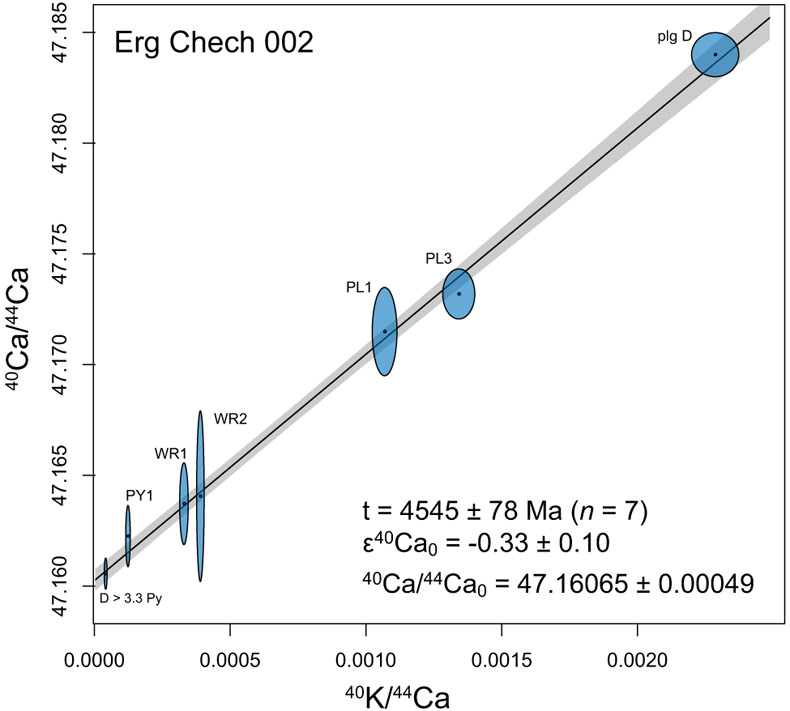
Figure 2 K-Ca isochron defined by pyroxenes, plagioclases, and bulk rock fractions of EC 002 using IsoplotR (Vermeesch, 2018
Vermeesch, P. (2018) IsoplotR: A free and open toolbox for geochronology. Geoscience Frontiers 9, 1479–1493. https://doi.org/10.1016/j.gsf.2018.04.001
). The error bars correspond to the 2 s.e. on the ratios. Seven data points define a linear array corresponding to a K-Ca age of 4545 ± 78 Ma for λ(40K) = 0.5543 Ga−1 (Steiger and Jäger, 1977Steiger, R.H., Jäger, E. (1977) Subcommission on geochronology: Convention on the use of decay constants in geo- and cosmochronology. Earth and Planetary Science Letters 36, 359–362. https://doi.org/10.1016/0012-821X(77)90060-7
).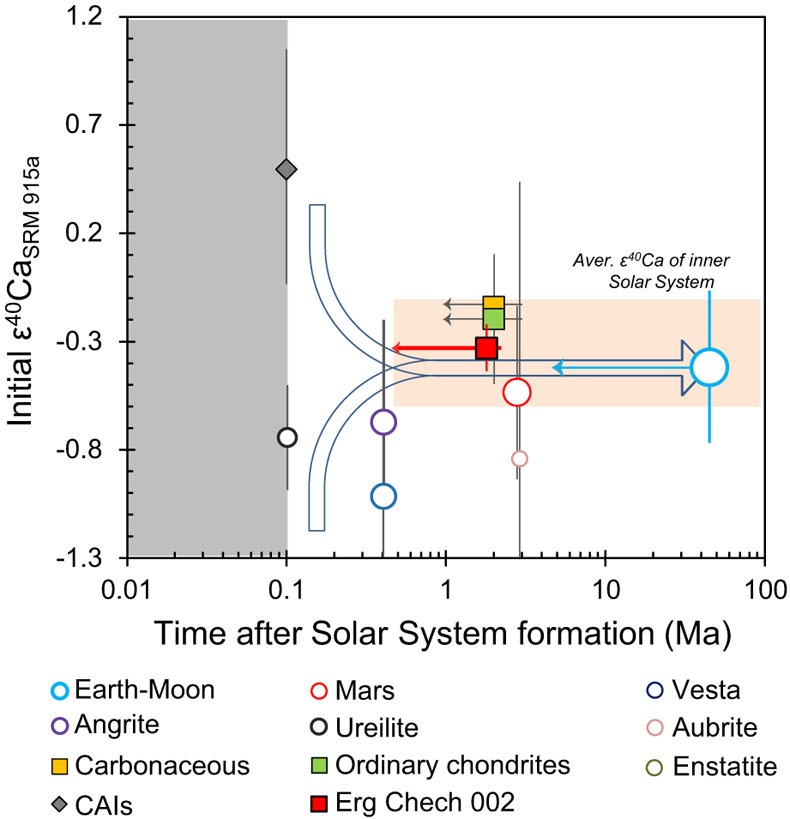
Figure 3 Time scale for homogenisation of ɛ40Ca values in the protoplanetary disk, after Simon et al. (2009)
Simon, J.I., DePaolo, D.J., Moynier, F. (2009) Calcium Isotope Composition of Meteorites, Earth, and Mars. The Astrophysical Journal 702, 707–715. https://doi.org/10.1088/0004-637X/702/1/707
. The ɛ40Ca of chondrites and planets are homogeneous since the formation of early planetesimals (∼1 Ma). The formation of CAIs is considered to represent the time of formation of formation of the Solar System or a maximum of ∼0.1 Ma after the formation of the Solar System (Montmerle et al., 2006Montmerle, T., Augereau, J.-C., Chaussidon, M., Gounelle, M., Marty, B., Morbidelli, A. (2006) 3. Solar System Formation and Early Evolution: the First 100 Million Years. Earth, Moon, and Planets 98, 39–95. https://doi.org/10.1007/s11038-006-9087-5
). Timing of accretion of different planet bodies is from Schiller et al. (2018)Schiller, M., Bizzarro, M., Fernandes, V.A. (2018) Isotopic evolution of the protoplanetary disk and the building blocks of Earth and the Moon. Nature 555, 507–510. https://doi.org/10.1038/nature25990
. The latest accretion ages of meteorites are set by their formation age: EC 002 (0.43–1.80 Ma, derived from the 26Al-26Mg system with different initial 27Al/26Al ratios; Fang et al., 2022Fang, L., Frossard, P., Boyet, M., Bouvier, A., Barrat, J.-A., Chaussidon, M., Moynier, F. (2022) Half-life and initial Solar System abundance of 146Sm determined from the oldest andesitic meteorite. Proceedings of the National Academy of Sciences 119, e2120933119. https://doi.org/10.1073/pnas.2120933119
); chondrites (mostly around 1–3 Ma; Krot et al., 2009Krot, A.N., Amelin, Y., Bland, P., Ciesla, F.J., Connelly, J., Davis, A.M., Huss, G.R., Hutcheon, I.D., Makide, K., Nagashima, K., Nyquist, L.E., Russell, S.S., Scott, E.R.D., Thrane, K., Yurimoto, H., Yin, Q.-Z. (2009) Origin and chronology of chondritic components: A review. Geochimica et Cosmochimica Acta 73, 4963–4997. https://doi.org/10.1016/j.gca.2008.09.039
). The ɛ40Ca values of different planets and chondrites are taken from literature, and detailed information is reported in Table S-3.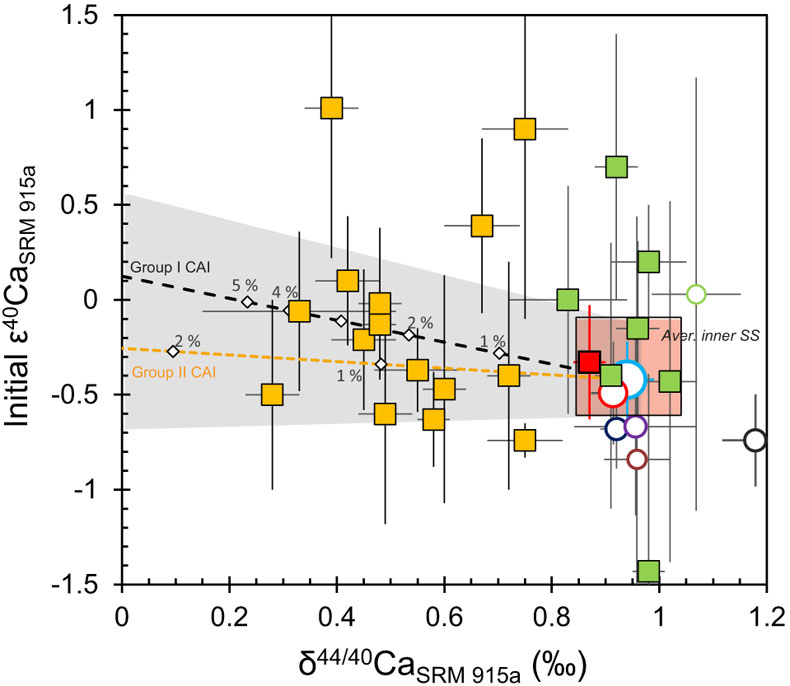
Figure 4 Plot of ɛ40Ca values versus δ44/40Ca values of different chondrites and planetary bodies; symbols as in Figure 3. The two dashed lines represent the mixing curves between bulk Earth and group I and II refractory inclusions. Detailed information is reported in Table S-3.


